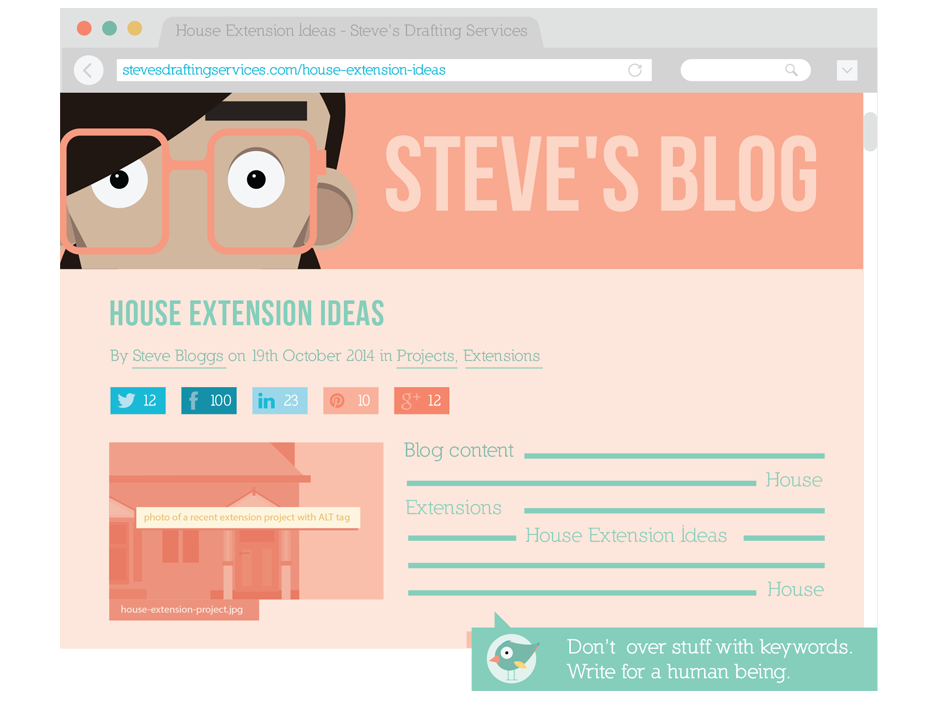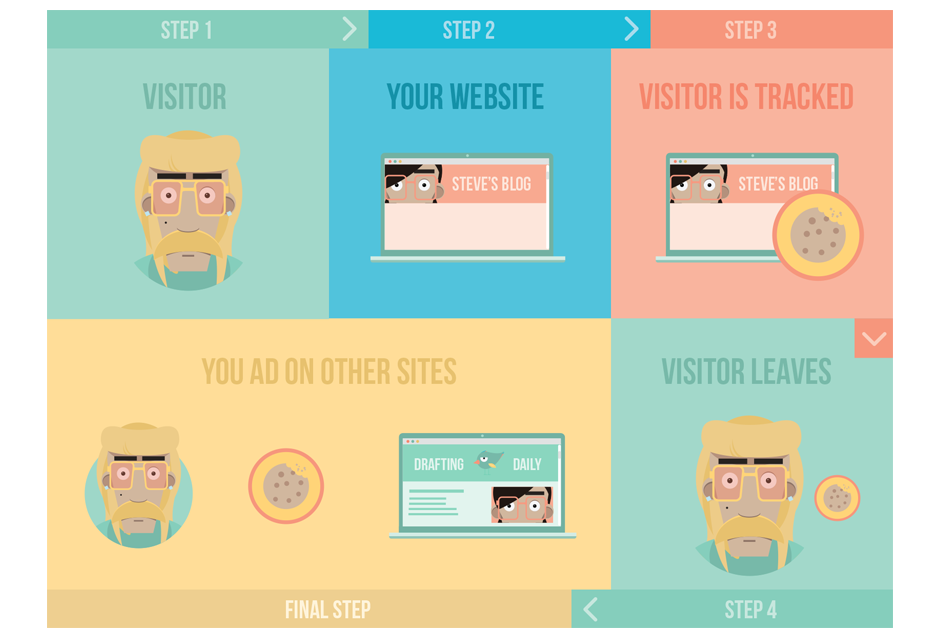Drive Traffic To Your Website
Drive Traffic To Your Website
Steve the details man
As we know, Steve is a man focused on the details. In fact, his mates would describe him as borderline obsessive compulsive. He likes to know the exact details of why he needs to be doing something and how this will get results for his business.
Now, by this stage Steve has created lots of great content and we need to give it the best possible chance of getting found by ensuring it is correctly optimised.
Optimising your website for Google has changed dramatically in recent years. SEO (search engine optimisation) is largely an ‘onsite game’. This means you need to ensure from the start that you choose the right platform and structure. Out of the box, WordPress is one of the best content management systems when it comes to SEO. Optimising your content will ensure you get more traffic and conversions from your website.
Typically your digital agency will cover off on these elements when building your website. It is still good however to have an understanding of each of these elements to ensure everything that should be done gets done and that you have the know how to manage this.

An overview of search engine optimisation
Google puts priority on the following:
- Content
The content of the page is the number one ranking factor in the eyes of Google which only wants great content. The quality of the page defines the ranking position, that is position 1 VS position 11. As we’ve discussed previously, we start with the premise of “build great content, get found”. Think deeply about the content you create and you will make it valuable, comprehensive and useful. The goal here is to produce content that someone would want to link back to or share.
Follow these guidelines:
- Ideally your page contains text, images and video.
- Keep your content very narrow and relevant to one specific topic. One page, one message.
- Your content should not be over manipulated or stuffed with keywords. As long as the content is written for a human being and isn’t ‘stuffed’ with the same keywords over and over again then you are off to a great start. Your subject should be mentioned a few times throughout the content in a conversational manner.
- Start with a philosophy of ‘provide value’ and you will be fine.
- Page titles
The page title is the main way of describing the page or post. The page title should be descriptive and unique for every page. It should be limited to 55 to 60 characters. Your subject should be mentioned in the first words of the title tag.
Title tags then show up in the Google search results similar to this:

- Meta description
In the Google search results, the small block of text is typically the page or post’s ‘meta description’. If this doesn’t exist, Google will just create one for you. Ideally this is a concise explanation of what the page is about. The description should be between 150 and 160 characters in total. The best rule of thumb is to create compelling copy that contains the keywords that relate to the page. Ensure you don’t have duplicate meta descriptions across other pages in your site (they all need to be unique). Sometimes the date will also be displayed in front of the meta description.


Oi, take note! – Title tags and Meta descriptions are handled extremely well by an plugin called ‘WordPress SEO by Yoast’ (https://yoast.com/wordpress/seo/)
- URL
The URL (Unique Resource Locator) is the address of the page.
For example https://www.wpbeginner.com/wp-tutorials/seo-friendly-url-structure-for-wordpress/
WEBSITE > CATEGORY > POST NAME
WordPress covers off on this as a default feature (the setting just needs to be tweaked). It gives you full control of how your URL (or permalink) is displayed.
This gives Google clues about the relevance of the content based on the hierarchy. It is a really great idea to include the subject or keywords of the blog post in the URL.
- Categories and tags
Using categories and tags on your WordPress website will increase the likelihood of your content getting found.
Categories allow for broad groupings of your posts. These are hierarchical in nature.
Tags are similar to categories but allow you to be very specific. These are intended to be two or three words at most. Tags help search engines get a better understanding of your post and how it relates to different topics.
For example:

- Title and ALT tags
Page/post title
Your page title should be set up as a H1 tag. This should be built into your website by your developer. The primary thing to remember is to include the subject in the title of the post as per this example:

Image optimisation
Your image has the opportunity to appear in the Google search results. Google reads all elements on the page including images. While Google can’t see the image as humans can, we need to be descriptive and tell it what the image is about. Things such as the file name and the ALT tag are important. In other words, give any pictures real names that align to the content. So instead of uploading ‘DSC000023.jpg’, rename the picture as ‘steves-moustache.jpg’ and upload the file.
The ALT tag allows you to specify a text description if the image isn’t available. The image you insert into your post should be relevant to the content. Insert your subject into the ALT tag when uploading an image via WordPress.

Sharing your content
Social sharing widgets
Part of the build process should include a social sharing plugin or ‘widget’ on your page. This allows users to one click ‘like’ or ‘tweet’ your post right from your website.

Sharing your content
With all of the previous tools in place and used, you can now get your content in front of your ideal customers through a variety of different platforms. No two businesses’ social media presence is the same. For example, it may be more appropriate for a draftsman to be more active on LinkedIn than on Facebook. This needs to be adapted to your business but the premise is the same for all social media options. Provide a link back to your blog post via your social media platforms. This will make both Google and your audience on the social platforms aware of your content, and hopefully they follow the link back to your website.
Here is a checklist for elements to include in each of your blog posts. You ideally want to:
- ensure your post has been ‘on-site’ optimised
- include video (hosted on Youtube.com and embedded on your page)
- Facebook ‘Like’ your post
- share your post with your Facebook community/page
- tweet link via Twitter
- include a Twitter feed widget (embedded on your site)
- share your post via the Google +1 button
- pin on Pinterest
- share on LinkedIn
- place photo on Instagram with URL in the description
- announce your post via your email newsletter.
The end result is your posts get indexed in Google!

Oi, take note! – Tip: For excellent training around this whole topic, visit: https://owntheracecourse.com put together by James Schramko.
Google+ authorship
In its simplest form, Google+ authorship is a ‘rich snippet’ byline that appears in the search results. By linking your Google+ account to your website, Google knows that an individual human being wrote that article. This displays the author’s name in the search engine results and increases your click through rates. In addition you will get more followers on your Google+ profile. Visitors can also locate other content you have created on your site.

Content creation schedule
Creating content consistently on your website can pay tremendous dividends. Like any good habit, it takes time and consistency to get it right and to get traction. When you are on the front line in the trenches of your business, making time to write a blog or record a video seems like a low priority. Try to change your mindset to a point where you recognise that you are actually contributing to the marketing of your business and the time you spend now will more than pay off in the future. Sales and marketing is what drives business growth. Creating content contributes to your marketing efforts.
Remember, content creation is a long term strategy to draw in, convert and communicate with your customers.
Start by setting a realistic goal. For example commit to doing one 500-word blog post every fortnight. Doing this consistently for a year will result in around 25 great pieces of content on your website for a variety of different topics. Set up a fortnightly reminder in your calendar and block out one hour. Allow nothing to interfere with this time. After a while, you will look forward to this creative time and the focus on the business it will give you.
Start by scheduling this in your calendar. If you are working in a team where multiple people will be contributing content then a content creation calendar may be useful. Allocate the time and make people accountable for their contribution. These calendars are freely available on the web and get all team members on the same page. They become a good repository for you to document future topics and it helps to keep the team focused.
Block out your allocated time and execute. Remember, being prolific will give you higher rankings over perfection. Ideas are cheap but putting pen to paper is what is going to get you the results and drive traffic to your website.
Once you form the habit, it will become a regular – and vital – part of your marketing schedule.

Download the love – Download a content creation schedule here: https://www.loveatfirstsite.net/download
Sharing via email marketing
Email has been around since the dawn of the internet. To this day there is still a role for email in your online toolkit. It is an effective vehicle to deliver a marketing message and stay in touch with your customers and prospects. Email marketing in its simplest form is the process of sending a bulk message to a list of email addresses. (If you don’t have an email list, re-read Chapter 5 to see how to build one.)
A relevant message, with a good offer to an engaged list can have a tremendous conversion rate. Even when competing against busy channels like social media, there is still no better way of getting eye balls or a click through to your offer than a well written, good looking, personalised email campaign.

An example
Take Ross for example – a very talented furniture designer who makes really beautiful furniture (visit https://www.rossgardam.com.au). He has a small but engaged list (around 1,000 subscribers in total). Due to the appeal of his product people naturally gravitate towards him and want to be kept up to date with changes to his product range. They actively subscribe through his website via a small subscription form embedded on his website. Ross is very selective about what is sent to the list and only sends out a newsletter every month or two keeping people abreast of a new product in his range. His email campaigns consistently achieve an ‘open rate’ of 50%+ (which is well above industry average of around 20%).
Why it works so well






In a bid to curb the abuse of email as a marketing tool, governments have legislated to protect the individual. In Australia, Privacy Act legislation compliance states that you must:
- have implicit or implied consent
- clearly identify yourself
- provide a way of opting out of future communications (unsubscribing).
There are serious penalties for any businesses in breach of these rules and they should not be taken lightly.
Different shapes and sizes
Email comes in a variety of different formats and can be shaped and adapted to your specific business including:
Email newsletter – A monthly or quarterly email providing good quality content delivered on a regular basis with links to news announcements, product updates, blog post summaries.
Summary or digest – Assuming you are adding a new blog post to your website every week, this format works well for summarising and linking each of the blog posts in a single list. Quick and easy for the recipient to consume.
Announcement email – Usually one message, one topic. These will go deeper into a specific topic, are text-based and have some sort of call to action, for example click for more information, buy now.
Transactional emails – More functional emails such as sales notifications, welcome messages and order status. Make these personal and fun (so they don’t seem so system generated). A good idea is add in a personal closing, for example “PS. Hit reply if you have a question.”
Email rules you must follow
- Stay relevant – Sure, you have permission to send email to your list but you must keep it worthwhile and interesting. If not, people will unsubscribe.
- Length – Keep it as short as possible. Get to the point.
- Summarise and link – Instead of putting the whole article in an email, provide an abstract summary in one to two lines and link to the full blog post. The end goal is to drive the traffic back to a specific page on your website.
- Frequency – Step into the mind of the end user. If you were a prospect, how often would you like to be informed about the particular product or service? As a rule of thumb, err on the side of caution and opt for fewer emails. You want to nurture the list, not annoy them.
- Never purchase lists – A purchased list is toxic. It has been marketed too many times over, the email addresses tend to be junk and your open rates will be so low it’s not worth bothering. Don’t do it!
- Use minimal images – Most email programs block images by default. Always design your email thinking that your images may not be displayed. This means that there will be greater emphasis on text. The best solution is to use a HTML email format with mainly text.
- Legal requirements – Ensure you clearly identify yourself, provide a physical address of the sender and provide an unsubscribe link. Most mainstream email solutions will cover off on this by default.
- Design – Keep to the same design fundamentals as your website. This will provide visual continuity and a consistent user experience. Ensure the layout also looks good on a mobile device.
Email marketing resources:
There are countless email marketing tools on the web. I recommend either of these two products:
- Campaign Monitor: https://www.campaignmonitor.com
- Mail Chimp: https://mailchimp.com/
A more advanced marketing automation platform allows you to set automated sequences and rules depending on user behaviour, for example:
- Infusionsoft: https://www.infusionsoft.com/
- Office Auto Pilot: https://www.officeautopilot.com/
Remarketing

This is a very powerful weapon in the small business’s advertising arsenal. This is a feature tied into Google paid advertising (AdWords) and can be a very low cost way of driving traffic to your website and building your brand.
Take Steve’s website for example.
A user went to www.google.com and typed in ‘house extension plans Melbourne’. A post on Steve’s website appeared (because of all his great content) and the prospect visited the page.
The user read his blog post but because they were only researching at the time, they got distracted and moved on from Steve’s website. Before they moved on, Steve’s website placed a unique identifier or ‘cookie’ (via a small snippet of code) on the user’s computer.
For the next 60 days, Steve can ‘follow’ this individual around the internet. Steve’s visual drafting advertisements promoting his drafting services are displayed across a big network of websites such as newspapers, portals or anyone who is part of Google’s advertising network.
Steve now has the opportunity to ‘re-ignite’ or drive the prospect back to the website. Even if the user doesn’t click back, the branding opportunities are huge as you aren’t paying for the ad to be displayed, only if it is clicked. This is a clever way of re-connecting with an individual who has shown some interest but didn’t get in touch the first time round.
This is a low cost strategy to stay front of mind and make your organisation and your marketing budget appear much bigger than it actually is.
Your digital agency or ‘pay per click’ company will be able to setup the tools to realise this powerful marketing strategy.
Measuring the success of your website
Like any marketing asset, the real key is to always track your website’s progress, measuring the results and refining the strategies.
So, how do you measure the success of your website?
Traffic
Traffic takes time to build up but once you get in the flow of content creation and consistently adding new valuable information the site will generate momentum.
Alerts from Google
Google Alerts is a free service which tracks your chosen search phrase and notifies you every time the search engine discovers a new page, article or blog in its results. It is good to put in the name of your blog, your author name or the topic name so you know each time something gets indexed.
Sales and enquiries
Do you know whether you generate more sales enquiries through your website via your contact form or by people picking up the phone? Ensure that ‘goals’ are set up through Google Analytics to accurately track this. Consistently ask your customers the question, “How did you find us?”
Interaction, social sharing and following
Are users interacting with the comments on your blog and asking questions or providing feedback? When the post is shared on your Facebook page do you get engagement? Are you getting new followers on these platforms?
Open rates and unsubscribes via email
When you notify your database of your new content and link through to it, do you get a good response from the opens and click throughs? Does this result in a spike in sales activity or does it have the opposite effect, with people unsubscribing and opting out of your communications?
Database opt-ins
Are users opting into your email list via the subscription form on your site? This is a good measure of engagement which shows if users want to see more of this type of content.
Conversion rate optimisation (CRO)
The definition of a conversion is when someone takes a step or action that we want them to take. For example, making a sale, subscribing to a newsletter or filling out a contact form.
It is far easier to increase conversions on your website rather than increase traffic to your website. For example, if your website only receives 10 visitors per day but you are able to convert three of those visitors, you have a 30% conversion rate. Imagine being able to convert an extra three visitors. This would be take you up to a 60% rate without any additional traffic.
In any website build, there will always be room for improvement. Conversion rate testing applies a scientific approach to the website statistics so you can make changes or improvements which will result in a higher number of conversions.
This is a little detailed for the purposes of this book but a company helping with CRO would analyse pages where:
- visitors are dropping off the site at higher-than-optimal levels
- conversions are particularly low
- traffic is particularly high.
Statistical computations are then run to figure out which pages are likely to result in the fastest, greatest gains.
The end goal is to always test and refine. Know your numbers in detail – after all you can’t manage what you can’t measure. Don’t think of your website as a fixed, finished object, rather a fluid and evolving entity.
Summary
We are getting there! A summary of what we covered:
- SEO (Search Engine Optimisation) is the process in getting Google to rank your site.
- WordPress is a great platform which defaults to many SEO friendly ways of structuring a site.
- Provide great content first of all and make sure each page of your site is optimised.
- Share your content via social media and email marketing.
- Block out time to create content making it a priority in your diary.
- Don’t forget email marketing – it’s still cost effective but do follow the ‘rules’.
- Remarketing, within Google’s AdWords is a powerful branding tool.
Awesome. Your content is optimised and being shared. In the next chapter we make sure that no technical hiccups get in the way of your ongoing success.
- Web Design Gold Coast
- Web Design Brisbane
- Web Design Melbourne
- Web Design Sydney
- Web Design Bundaberg
- Web Design Cairns
- Web Design Hervey Bay
- Web Design Mackay
- Web Design Rockhampton
- Web Design Toowoomba
- Web Design Townsville
- Web Design Sunshine Coast
- Shopify Gold Coast
- Facebook Ads Agency Gold Coast
- SEO Packages Brisbane
- SEO Packages Sydney
- SEO Packages Perth
- SEO Packages Melbourne
Five by Five acknowledges the Traditional Custodians of this land. We pay respect to their Elders past, present and emerging for their wisdom, teaching and cultural knowledge and extend that respect to other Aboriginal and Torres Strait Islander peoples.
Five by Five are based on the Gold Coast and provide great looking high performing websites for businesses Australia wide including Brisbane, Sydney, Melbourne, Adelaide, Canberra, Perth – all regions and cities of Australia.





